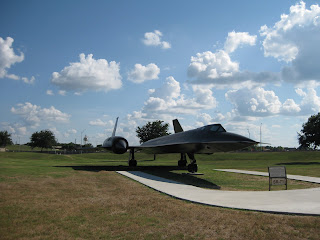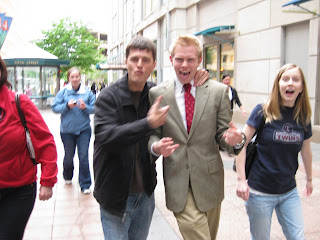Well, today was the first of several things I've been looking forward to: we "flew" in the altitude chambers in the Aerospace Physiology facility. That may not sound all that exciting to someone who's never done it or even thought about it, but let me assure you that it is a
big deal. After a short briefing, we were fitted for helmets and oxygen masks. I have to say that the mask-fitting and some of the later pressure-breathing were probably the closest I've ever felt to being claustrophobic; I definitely take the ease of breathing at ground level, unimpeded by any sort of hardware, for granted. (Understandably.) As soon as we were fitted, we entered the chamber, plugged all the hoses and cables in, and awaited further instruction.
The first task was to "ascend" to 5,600 feet for an ear-and-sinus check. Basically, the chamber's conditions mimic the conditions at these different altitudes. As the air thins out, there's a lot less total pressure as well as partial pressure of oxygen. The ascension from ground level to 5,600 feet took care of a bulk of the reduction in pressure, so if we had no problem clearing our ear canals to equalize to the new pressure at that altitude, then we were fine to ascend higher. We didn't ascend any higher yet, though. We actually descended back to ground level for 30 minutes of de-nitrogenation; we cinched our masks so they were completely sealed (actually a little painful, to be honest) and breathed 100% oxygen to prevent later decompression sickness as much as possible. Then it was time to go up.
I had no problem getting my ears and sinuses to equalize as we rose to 25,000 feet -- and then it was time for some fun. On cue, we removed our masks and began breathing the extremely thin air at an altitude whose Time of Useful Consciousness is rated at 3-5 minutes for the average person. The goal of the exercise was so that we could all experience the first few symptoms of hypoxia and then put our masks back on unaided. The point is that, if we were in an airplane undergoing gradual decompression, we would hopefully be able to recognize that we were becoming hypoxic and be able to take emergency, corrective measures before we got to the point of passing out. (This would certainly be useful if you were, for example, a doctor in the back of a transport plane taking care of patients. If the doctor becomes hypoxic and passes out, then the patients wouldn't even have a chance.) My best way of describing the symptoms of hypoxia would be to compare it to the effects of drinking alcohol, but slightly different. I was sad that I didn't feel any tingling or numbness (two of the common effects), but I
did feel lightheaded, a bit slow-thinking, and cotton-mouthed. When I was asked to count backward from 100 by 3's, I failed somewhere in the 70's and decided that those 6 minutes or so were enough; I had successfully experienced my first symptoms of hypoxia.
Once we had all "cleared the cobwebs" by breathing the 100% oxygen again, we descended to 18,000 feet, where we did our next exercise, which had to do with night vision. The Time of Useful Consciousness at this level is 20-30 minutes, but this was a good level to demonstrate just how important oxygen is for night vision. As our eyes adjusted to the dark, we could gradually make out different colors on our individual color wheels. At the same time, the gradual oxygen deprivation caused our brains to suck away oxygen from the nearest source: the rod cells in the eyes, which are the ones responsible for low-light vision. A few minutes later we were instructed to hold our masks back up while still paying attention to the color charts in front of us. Three deep breaths later, the reds and oranges suddenly popped out, and everything acquired a fleeting reddish glow. I had experienced the "red flash" that often accompanies a rapid return of oxygen perfusion.
After a few different exercises in which we felt what it was like to breathe under high pressure (not so pleasant), we came back to ground level. Our final exercise was one of rapid decompression. We learned how to use the quick-don masks, and then, without warning, we decompressed from 1,000 feet to 11,000 feet in a split-second. The water vapor in the air turned to mist, the temperature immediately plummeted, and we rushed to grab our oxygen. It was great!
Now all of us are on the lookout for signs of decompression sickness. I haven't felt any joint pain or noticed any rashes yet, so hopefully I'm in the clear. Throughout the day I've been popping my ears a bit more than usual; apparently the 100% oxygen that we used to perfuse all of our tissues has to somehow leak back out again, and it commonly comes through the ears. We have all been warned not to panic if we wake up at 2 a.m. with a huge pain in our ears requiring a loud, painful POP! It's just the oxygen.


























